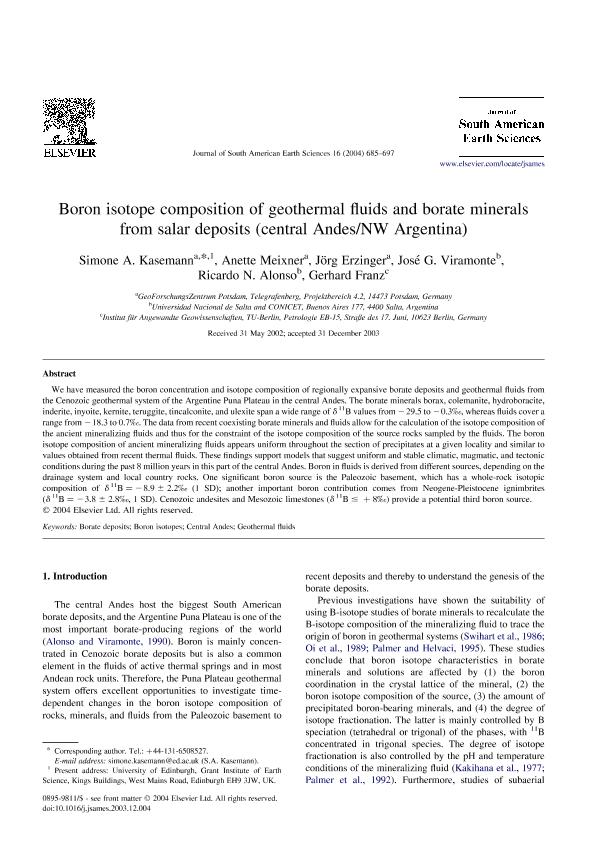Mostrar el registro sencillo del ítem
dc.contributor.author
Kasemann, Simone A.
dc.contributor.author
Meixner, Anette
dc.contributor.author
Erzinger, Jörg
dc.contributor.author
Viramonte, Jose German

dc.contributor.author
Alonso, Ricardo Narciso

dc.contributor.author
Franz, Gerhard
dc.date.available
2023-02-02T02:45:34Z
dc.date.issued
2004-06
dc.identifier.citation
Kasemann, Simone A.; Meixner, Anette; Erzinger, Jörg; Viramonte, Jose German; Alonso, Ricardo Narciso; et al.; Boron isotope composition of geothermal fluids and borate minerals from salar deposits (central Andes/NW Argentina); Pergamon-Elsevier Science Ltd; Journal of South American Earth Sciences; 16; 8; 6-2004; 685-697
dc.identifier.issn
0895-9811
dc.identifier.uri
http://hdl.handle.net/11336/186539
dc.description.abstract
We have measured the boron concentration and isotope composition of regionally expansive borate deposits and geothermal fluids from the Cenozoic geothermal system of the Argentine Puna Plateau in the central Andes. The borate minerals borax, colemanite, hydroboracite, inderite, inyoite, kernite, teruggite, tincalconite, and ulexite span a wide range of d 11B values from 229.5 to 20.3‰, whereas fluids cover a range from 218.3 to 0.7‰. The data from recent coexisting borate minerals and fluids allow for the calculation of the isotope composition of the ancient mineralizing fluids and thus for the constraint of the isotope composition of the source rocks sampled by the fluids. The boron isotope composition of ancient mineralizing fluids appears uniform throughout the section of precipitates at a given locality and similar to values obtained from recent thermal fluids. These findings support models that suggest uniform and stable climatic, magmatic, and tectonic<br />conditions during the past 8 million years in this part of the central Andes. Boron in fluids is derived from different sources, depending on the drainage system and local country rocks. One significant boron source is the Paleozoic basement, which has a whole-rock isotopic composition of d 11B ¼ 28.9 ^ 2.2‰ (1 SD); another important boron contribution comes from Neogene-Pleistocene ignimbrites (d 11B ¼ 23.8 ^ 2.8‰, 1 SD). Cenozoic andesites and Mesozoic limestones (d 11B # þ 8‰) provide a potential third boron source.
dc.format
application/pdf
dc.language.iso
eng
dc.publisher
Pergamon-Elsevier Science Ltd

dc.rights
info:eu-repo/semantics/openAccess
dc.rights.uri
https://creativecommons.org/licenses/by-nc-sa/2.5/ar/
dc.subject
BORATE DEPOSITS
dc.subject
BORON ISOTOPES
dc.subject
CENTRAL ANDES
dc.subject
GEOTHERMAL FLUIDS
dc.subject.classification
Geología

dc.subject.classification
Ciencias de la Tierra y relacionadas con el Medio Ambiente

dc.subject.classification
CIENCIAS NATURALES Y EXACTAS

dc.title
Boron isotope composition of geothermal fluids and borate minerals from salar deposits (central Andes/NW Argentina)
dc.type
info:eu-repo/semantics/article
dc.type
info:ar-repo/semantics/artículo
dc.type
info:eu-repo/semantics/publishedVersion
dc.date.updated
2021-04-28T20:43:22Z
dc.journal.volume
16
dc.journal.number
8
dc.journal.pagination
685-697
dc.journal.pais
Estados Unidos

dc.journal.ciudad
Amsterdam
dc.description.fil
Fil: Kasemann, Simone A.. German Research Centre for Geosciences; Alemania
dc.description.fil
Fil: Meixner, Anette. German Research Centre for Geosciences; Alemania
dc.description.fil
Fil: Erzinger, Jörg. German Research Centre for Geosciences; Alemania
dc.description.fil
Fil: Viramonte, Jose German. Universidad Nacional de Salta; Argentina. Consejo Nacional de Investigaciones Científicas y Técnicas; Argentina
dc.description.fil
Fil: Alonso, Ricardo Narciso. Universidad Nacional de Salta; Argentina. Consejo Nacional de Investigaciones Científicas y Técnicas; Argentina
dc.description.fil
Fil: Franz, Gerhard. Technishe Universitat Berlin; Alemania
dc.journal.title
Journal of South American Earth Sciences

dc.relation.alternativeid
info:eu-repo/semantics/altIdentifier/doi/http://dx.doi.org/10.1016/j.jsames.2003.12.004
Archivos asociados
